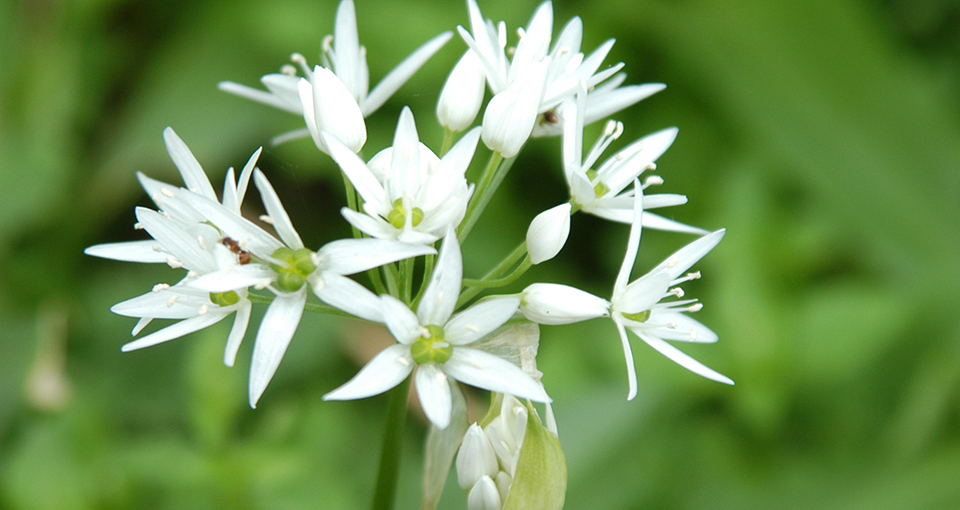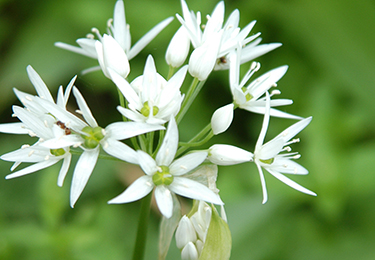
Watchlist
You can print out your watchlist and use it as a reminder for your purchase in the pharmacy.
Your watchlist currently contains no products.
Print


Bear’s garlic
Bear’s garlic
Botanik
Bear’s garlic (allium ursinum) – in contrast to garlic – is an indigenous leek plant which grows wild throughout Europe. It is found particularly in moist, humus-rich and shady wooded gorges and beech woods, where it covers wide areas of the ground in spring. Bear’s garlic is a typical earlier flowerer and, with its white, star-shaped blossoms arranged in an illusory umbel, it only has a short vegetation period. The bulbs begin to push up in March and the plants, with a height of 20-30 cm, complete their life cycle when the seeds mature and the lancet-shaped leaves are drawn in.
mehr
Geschichte
Europeans have been using bear’s garlic as an indigenous nutritional plant for many centuries. Throughout countless generations our central European organisms have acquired a recollection pattern for this plant, just as the organism of an Asian is “calibrated” for the enjoyment of garlic. The name “Bear’s garlic” goes back to the Teutons. They observed that in spring the brown bears – which at that time still roamed our forests – consumed the wild vegetables by the ton and in this way literally obtained “bear-like strength”. No wonder that our forefathers imitated the bears and incorporated the leek plant in their meals. There is also another theory, however, that our ancestors processed the meat of bears with leek so the name “Bear’s garlic” goes back to the “bear ham“ of the Proto-Germans. In monastic medicine in the Middle Ages bear’s garlic gained in significance but gradually sank into oblivion again with the rise of alchemy and iatrochemistry. The romanticism of the 19th century finally brought a return to the forces of nature with its “inexplicable, mystic healing powers “. With the advent of pharmacy and instrumental medicine in the 20th century, knowledge about bear’s garlic was repressed – only to be rediscovered by Dr. Pandalis- Research – strange but true !
mehr
Inhaltsstoffe
Bear’s garlic distinguishes itself by means of its especially high sulphur content – active compounds (sulphur in reduced form). In contrast to garlic with its 1.7 g sulphur, bear’s garlic contains a proud 7.8 g of sulphur per 100 g dried substance. Some of the substances containing sulphur such as glutathione, cysteine and cysteine-S-oxide occur genuinely, i.e. “naturally” in the plant. On the other hand, compounds which only arise through damage to the plant are not genuine. Thus sulphurous acids and enzymes are formed when the leaves are cut off. Furthermore, bear’s garlic is rich in mineral substances such as iron, magnesium and manganese and contains adenosine and traces of selenium. The properties of selenium are very similar to sulphur and can sometimes replace it in biochemical systems.
mehr
Produkte mit Bear’s garlic
Bärlauch Bio Granulat
Organic Bear’s Garlic Granulate

Bärlauch Eisen N Kapseln
Wild Garlic Iron N Capsules

Bärlauch Frischblatt Granulat
Bear’s Garlic Fresh-Leaf Granulate

Bärlauch Frischblatt Kapseln
Bear’s Garlic Fresh-Leaf Capsules

Bärlauch Frischblatt Mastitabs®
Bear’s Garlic Fresh-Leaf Mastitabs®

Bärlauch Magnesium Kapseln
Bear’s Garlic Magnesium Capsules

Bärlauch Vitamin K1 Tabletten
Bear's Garlic Vitamin K1 Tablets

Lefteria®

Vitamin ABCE Pandalis Bio Granulat
Vitamin ABCE Granulate

Bärlauch Bio vegan Kapseln
Available in your pharmacy

Magnesium vegan Kapseln
Available in your pharmacy

Eisen Bio vegan Kapseln
Available in your pharmacy.
